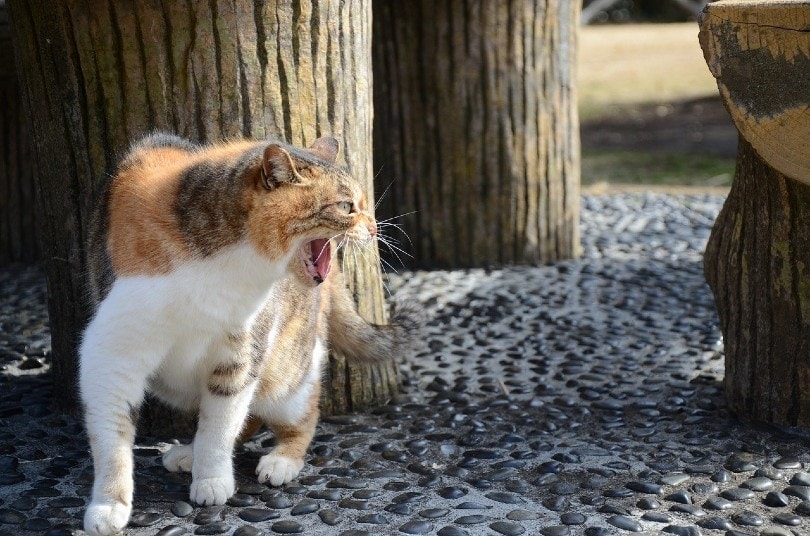Cats bite each other’s necks as a form of dominance or affection. This behavior is known as neck biting in the feline world.

Have you noticed your cat biting your other cat’s neck? Don’t worry, this behavior is completely natural and typical for felines. Cats often bite each other to show dominance or affection. In some cases, one cat may simply be trying to clean the other’s fur, and biting the neck is the easiest way to reach certain areas.
However, if the biting becomes excessive or aggressive, it may be necessary to intervene and redirect their behavior. Understanding why cats engage in neck biting can help you determine if it is normal or if action needs to be taken to ensure your cats’ safety and well-being.

Cat Biting Behavior
Cats biting each other’s necks can be explained by various behaviors. Instinctual behavior is normal and may be exhibited when hunting. Playful behavior involves play fighting. Dominance behavior is shown when one cat tries to assert dominance over the other.
Fear or anxiety behavior is seen in fearful cats. To differentiate between these biting behaviors, observe the cats’ body language and the circumstances surrounding the bites. Each cat may require different forms of intervention. Understanding the reasons behind biting behavior can help you identify the cause and properly address it without resorting to punishment.
Effects Of Neck Biting On Cats
Biting on the neck is a common behavior observed in cats. This can cause physical injuries like wounds and scratches. Additionally, neck biting can lead to psycho-social issues like anxiety and aggression. Owners must observe such behavior keenly and address it immediately to avoid long-term problems.
It’s important to understand that cats are territorial creatures and often exhibit dominance through aggressive behavior. Thus, if this behavior isn’t observed and addressed, it can result in a painful and stressful environment for both felines. If your cats are fighting frequently, it’s important to separate them and seek advice from a veterinarian or animal behaviorist to ensure proper intervention.
Preventing Neck Biting Behavior
Cats are known to display aggressive behavior towards each other. To prevent neck biting behavior, understanding cat body language can help. Providing adequate resources like toys and litter boxes can also reduce tension. Positive reinforcement training, such as rewarding calm behavior, can encourage non-aggressive behavior.
Another option is to use pheromone diffusers or sprays to calm cats. Overall, it’s important to create a peaceful and stress-free environment for cats living together. By taking these steps, you can reduce the likelihood of neck biting and other types of aggression between your cats.
Addressing Existing Neck Biting Behavior
Neck biting behavior in cats can be a troubling issue for pet owners. It’s important to take action to prevent harm to the animals. One of the first steps to take is to separate the cats temporarily. If the behavior persists, it may be time to consult with a veterinarian or animal behaviorist for guidance.
They may recommend potential medication or therapy options to help address the issue. As a cat owner, it is essential to be proactive in addressing any concerning behavior to ensure the safety and well-being of all pets involved.
Frequently Asked Questions Of Why Is My Cat Biting My Other Cat’S Neck
Why Is My Cat Biting My Other Cat'S Neck?
This could be a sign of play, affection, or aggression. If they are playing, they will take turns chasing and biting. If they are showing affection, they may groom each other’s necks. However, if aggressive, it’s important to intervene and separate them.
How Do I Stop My Cat From Biting My Other Cat'S Neck?
You can stop your cat from biting your other cat’s neck by redirecting their attention to a toy or another activity. You can also create space for each cat to have their own territory and resources. Additionally, consider consulting with a cat behaviorist for guidance.
Is It Normal For Cats To Bite Each Other'S Necks?
Yes, it is normal for cats to bite each other’s necks as a part of their playful behavior or affection. However, if the biting is aggressive and causing injuries, you should intervene and seek professional help.
How Do I Tell If My Cats Are Playing Or Fighting?
When cats are playing, they will take turns chasing, pouncing, and biting each other in a gentle manner. They will also have relaxed body language and may make chirping sounds. However, when fighting, they will hiss, growl, and engage in aggressive biting and scratching.
Conclusion
As a cat owner, it can be concerning to see one cat biting another’s neck. However, it is important to remember that this behavior is normal for cats and is often a sign of affection and dominance. In most cases, it is not violent or harmful to either cat.
However, if the biting does become aggressive or frequent, it may be worth consulting a veterinarian or animal behaviorist. It is also important to ensure that both cats have their own space and resources to prevent competition and territorial behavior.
By understanding the reasons behind this behavior and taking steps to promote harmony, cat owners can ensure a happy and healthy relationship between their feline companions.












GIPHY App Key not set. Please check settings